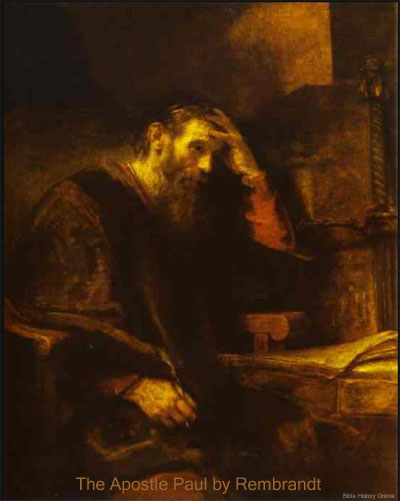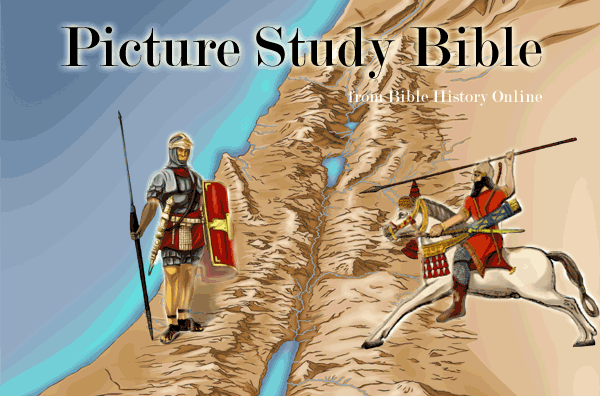Colossians 1:18 And he is the head of the body, the church: who is the beginning, the firstborn from the dead; that in all things he might have the preeminence. - Free Bible Online
Colossians 1:18 He is also head of the body, the church; and He is the beginning, the first-born from the dead; so that He Himself might come to have first place in everything.
18. Revelation of Christ to the Church and the new creation, as the
Originator of both.
he--emphatical. Not angels in opposition to the false teachers'
doctrine concerning angel-worship, and the power of Oeons or (imaginary)
spirit emanations from God
(Col 2:10, 18).
head of the body, the church--The Church is His body by virtue of
His entering into communion corporeally with human nature
[NEANDER],
(Eph 1:22).
The same One who is the Head of all things and beings by creation, is
also, by virtue of being "the first-born from the dead," and so "the
first-fruits" of the new creation among men, the Head of the Church.
who is--that is, in that He is the Beginning
[ALFORD]. Rather, this
is the beginning of a new paragraph. As the former paragraph, which
related to His originating the physical creation, began with "Who is"
(Col 1:15);
so this, which treats of His originating the new creation, begins with
"who is"; a parenthesis preceding, which closes the former paragraph,
that parenthesis (see on
Col 1:16),
including from "all things were created by Him," to "Head of the body,
the Church." The head of kings and high priests was anointed, as
the seat of the faculties, the fountain of dignity, and original
of all the members (according to Hebrew etymology). So Jesus by
His unction was designated as the Head of the body, the Church.
the beginning--namely, of the new creation, as of the old
(Pr 8:22;
Joh 1:1;
compare
Re 1:8):
the beginning of the Church of the first-born
(Heb 12:23),
as being Himself the "first-born from the dead"
(Ac 26:23;
1Co 15:20, 23).
Christ's primogeniture is threefold: (1) From eternity the
"first-begotten" of the Father
(Col 1:15);
(2) As the first-born of His mother
(Mt 1:25);
(3) As the Head of the Church, mystically begotten of the Father, as it
were to a new life, on the day of His resurrection, which is His
"regeneration," even as His people's coming resurrection will be their
"regeneration" (that is, the resurrection which was begun in the soul,
extended to the body and to the whole creation,
Ro 8:21, 22)
(Mt 19:28;
Ac 13:33;
Re 1:5).
Sonship and resurrection are similarly connected
(Lu 20:36;
Ro 1:4; 8:23;
1Jo 3:2).
Christ by rising from the dead is the efficient cause
(1Co 15:22),
as having obtained the power, and the exemplary cause, as being the
pattern
(Mic 2:13;
Ro 6:5;
Php 3:21),
of our resurrection: the resurrection of "the Head" involves
consequentially that of the members.
that in all things--He resumes the "all things"
(Col 1:20).
he might have the pre-eminence--Greek, "He
HIMSELF may (thus) become the One holding
the first place," or, "take the precedency." Both ideas are included,
priority in time and priority in dignity: now in the
regenerated world, as before in the world of creation
(Col 1:15).
"Begotten before every creature, or "first-born of every creature"
(Ps 89:27;
Joh 3:13).
JFB.
Questions Related to this Verse
Where in Scripture does it say that Jesus Christ is the head of the Church?Where in Scripture does it mention The resurrection of Jesus?
Where In Scripture Does It Talk About The Resurrection Of Jesus Christ?
Select a Chapter
Select a Book of the Bible
-
Genesis |
Exodus |
Leviticus |
Numbers |
Deuteronomy |
Joshua |
Judges |
Ruth |
1 Samuel |
2 Samuel |
1 Kings |
2 Kings |
1 Chronicles |
2 Chronicles |
Ezra |
Nehemiah |
Esther |
Job |
Psalms |
Proverbs |
Ecclesiastes |
Song of Solomon |
Isaiah |
Jeremiah |
Lamentations |
Ezekiel |
Daniel |
Hosea |
Joel |
Amos |
Obadiah |
Jonah |
Micah |
Nahum |
Habakkuk |
Zephaniah |
Haggai |
Zechariah |
Malachi |
Matthew |
Mark |
Luke |
John |
Acts |
Romans |
1 Corinthians |
2 Corinthians |
Galatians |
Ephesians |
Philippians |
Colossians |
1 Thessalonians |
2 Thessalonians |
1 Timothy |
2 Timothy |
Titus |
Philemon |
Hebrews |
James |
1 Peter |
2 Peter |
1 John |
2 John |
3 John |
Jude |
Revelation |
The Book of Colossians
Colossians 1:16 - For by him were all things created, that are in heaven, and that are in earth, visible and invisible, whether [they be] thrones, or dominions, or principalities, or powers: all things were created by him, and for him:
Colossians 2:15-17 - [And] having spoiled principalities and powers, he made a shew of them openly, triumphing over them in it. Let no man therefore judge you in meat, or in drink, or in respect of an holyday, or of the new moon, or of the sabbath [days]: Which are a shadow of things to come; but the body [is] of Christ.
Colossians in The New Testament - A Brief Overview

Painting of Paul the Apostle by Rembrandt - 1657
Introduction to The Book of Colossians
Brief Summary. Paul had been imprisoned at Rome and received messages about heresies at the church in Colossae. Paul defended the faith by exalting the person of Jesus, and clarifying the true doctrine of Jesus Christ.
Summary of The Book of ColossiansPurpose. The purpose of Paul's epistle to the Colossians is to instruct the believers that salvation is only in Jesus Christ. The person of Jesus Christ must be understood accurately and that "He is the image of the invisible God and in Him all the fulness of the Godhead dwells in bodily form (Colossians 1:15, 19). When Jesus died on the cross he put an end to the civil and ceremonial laws of Judaism. Believers can trust in the finished work of Jesus Christ, our God and creator.
Contents. The epistle to the Colossians contains Paul's instruction about the new life in Christ which comes through a spiritual union with Christ in heaven. This new life produces a Christlike character: brotherly affection, forgiveness, peace, worship and ministry, devotion to Christ, and thankfulness in everything.
Colossae. The city of Colossae was in the heart of New Testament Asia about a hundred miles east of Ephesus, in the Lycus River Valley, in southern Phrygia Colossae was situated on the great highway which ran from Ephesus to the Euphrates Valley, near Hierapolis and Laodicea. According to Colossians 4:12-15 the church had been established in Colossae some time earlier and was Paul sternly warns the church regarding angel-worship, especially that of Michael the Archangel.
The Church at Colossae. Paul does not name himself as the founder of the church at Colossae, yet since he passed through the region of Phrygia (Acts 16:6; 18:23) which the city of Colossae was a part of, it may be assumed that Paul came there and preached Christianity.
The Heresy. The Church at Colossae was being severely attacked by false teachers. The heresy contained many false teachings which included: a false view of the universe, matter is evil, a distortion of man, sin is physical not spiritual, abstaining from foods and asceticism, a misunderstanding of the person of Jesus Christ and the Logos, the worship of angels, and elements of Judaism mixed with Christianity.
Authorship. The epistle to the Colossians was written by Paul the Apostle and included with his prison epistles.
Date. Colossians was written from Rome during Paul's first imprisonment, about 61-62 AD.
Outline of the Book of Colossians
Jesus Christ Exalted - Chapter 1
Christianity Exalted - Chapters 2
Union with Christ Exalted - Chapter 3-4

The Name Jesus In Ancient Hebrew Text
"Yeshua" in First Century Hebrew Text. This is how the name "Jesus"
would have been written in ancient Hebrew documents. The four letters or
consonants from right to left are Yod, Shin, Vav, Ayin (Y, SH, OO, A).
Jesus is the Greek name for the Hebrew name Joshua or Y'shua which means
"The LORD or Yahweh is Salvation".
Colossians Maps and Resources
Map of the Roman Empire (14 A.D.) - This map reveals the Roman Empire during the time shortly after the birth of Jesus, in 14 AD at the time of the death of Augustus. The order which prevailed in this extensive empire, the good military roads, and the use of Koine Greek as the general language of culture throughout the area were among the factors which multiplied the rapid spread of the Gospel of Jesus Christ. (Color Map)
Map of Paul's First Missionary Journey (48 A.D.) - This map reveals the areas in Asia Minor where Paul visited in his first missionary journey. Around 48 AD, in the springtime, Paul and his companions Barnabas and Mark were sent on a mission from the church in Antioch. This would be the first of Paul's Missionary Journey's. (Color Map)
Map of Paul's Second Missionary Journey (51 A.D.) - This map reveals the areas in Asia and Greece where Paul visited in his second missionary journey. Paul re-visits a couple cities in Asia, one of which was Lystra where he was stoned and left for dead a few years earlier. He later has a vision that leads him over to Greece and Paul and his companions travel and minister in various cities in Greece (Philippi, Thessalonica, Berea, Athens and Corinth. Later Paul returns to Ephesus and finally to Caesarea and Antioch. (Color Map)
Map of Paul's Third Missionary Journey (54 A.D.) - This map reveals the areas in Asia and Greece where Paul visited in his third missionary journey. On Paul's third missionary journey he returned to the cities he had first visited on his first missionary journey. During this time he decided to remain in Ephesus for about 3 years, and this city was the main focus of his activities and an important Christian community (Acts 19). (Color Map)
Map of the New Testament World - This map reveals the "Nations" within the ancient world during the first century A.D., the time of the New Testament. The map includes the areas of Israel, Asia, Greece, and Italy. (Color Map)
Map of New Testament Asia - This map shows the cities within
Asia Minor during the first century A.D., the time of the New
Testament. The map includes the principal cities of Asia
including Tarsus, Ephesus, and Colossae, and provinces like
Galatia and Pamphilia. (Color Map)
Bibliography Information
Free Bible Online Picture Study Bible, King James Version. New York: American Bible Society: www.free-bible.com, 1995-2013. Bible History Picture Study Bible. May 18, 2024.
- King James Bible Home
- Free Bible Home Page
- Bible Encyclopedia (ISBE)
- Online Bible (KJV)
- Naves Topical Bible
- Smith's Bible Dictionary
- Easton's Bible Dictionary
- Fausset's Bible Dictionary
- Matthew Henry Bible Commentary
- Hitchcock's Bible Dictionary
Read The Bible
- 1599 Geneva Bible (GNV)
- 21st Century King James Version (KJ21)
- American Standard Version (ASV)
- Amplified Bible (AMP)
- Amplified Bible, Classic Edition (AMPC)
- Authorized (King James) Version (AKJV)
- BRG Bible (BRG)
- Christian Standard Bible (CSB)
- Common English Bible (CEB)
- Complete Jewish Bible (CJB)
- Contemporary English Version (CEV)
- Darby Translation (DARBY)
- Disciples’ Literal New Testament (DLNT)
- Douay-Rheims 1899 American Edition (DRA)
- Easy-to-Read Version (ERV)
- English Standard Version (ESV)
- English Standard Version Anglicised (ESVUK)
- Evangelical Heritage Version (EHV)
- Expanded Bible (EXB)
- GOD’S WORD Translation (GW)
- Good News Translation (GNT)
- Holman Christian Standard Bible (HCSB)
- International Children’s Bible (ICB)
- International Standard Version (ISV)
- J.B. Phillips New Testament (PHILLIPS)
- Jubilee Bible 2000 (JUB)
- King James Version (KJV)
- Lexham English Bible (LEB)
- Living Bible (TLB)
- Modern English Version (MEV)
- Mounce Reverse Interlinear New Testament (MOUNCE)
- Names of God Bible (NOG)
- New American Bible (Revised Edition) (NABRE)
- New American Standard Bible (NASB)
- New American Standard Bible 1995 (NASB1995)
- New Catholic Bible (NCB)
- New Century Version (NCV)
- New English Translation (NET)
- New International Reader's Version (NIRV)
- New International Version - UK (NIVUK)
- New International Version (NIV)
- New King James Version (NKJV)
- New Life Version (NLV)
- New Living Translation (NLT)
- New Matthew Bible (NMB)
- New Revised Standard Version (NRSV)
- New Revised Standard Version Catholic Edition (NRSVCE)
- New Revised Standard Version, Anglicised (NRSVA)
- New Revised Standard Version, Anglicised Catholic Edition (NRSVACE)
- New Testament for Everyone (NTE)
- Orthodox Jewish Bible (OJB)
- Revised Geneva Translation (RGT)
- Revised Standard Version (RSV)
- Revised Standard Version Catholic Edition (RSVCE)
- The Message (MSG)
- The Voice (VOICE)
- Tree of Life Version (TLV)
- World English Bible (WEB)
- Worldwide English (New Testament) (WE)
- Wycliffe Bible (WYC)
- Young's Literal Translation (YLT)
Table of Contents
Main Menu
- Ancient Assyrian Social Structure
- Ancient Babylonia
- Ancient Canaan During the Time of Joshua
- Ancient History Timeline
- Ancient Oil Lamps
- Antonia Fortress
- Archaeology of Ancient Assyria
- Assyria and Bible Prophecy
- Augustus Caesar
- Background Bible Study
- Bible
- Biblical Geography
- Fallen Empires - Archaeological Discoveries and the Bible
- First Century Jerusalem
- Glossary of Latin Words
- Herod Agrippa I
- Herod Antipas
- Herod the Great
- Herod's Temple
- High Priest's in New Testament Times
- Jewish Literature in New Testament Times
- Library collection
- Map of David's Kingdom
- Map of the Divided Kingdom - Israel and Judah
- Map of the Ministry of Jesus
- Matthew Henry Bible Commentary
- Messianic Prophecy
- Nero Caesar Emperor
- Online Bible Maps
- Paul's First Missionary Journey
- Paul's Second Missionary Journey
- Paul's Third Missionary Journey
- Pontius Pilate
- Questions About the Ancient World
- Tabernacle of Ancient Israel
- Tax Collectors in New Testament Times
- The Babylonian Captivity
- The Black Obelisk of Shalmaneser
- The Books of the New Testament
- The Court of the Gentiles
- The Court of the Women in the Temple
- The Destruction of Israel
- The Fall of Judah with Map
- The History Of Rome
- The Incredible Bible
- The Jewish Calendar in Ancient Hebrew History
- The Life of Jesus in Chronological Order
- The Life of Jesus in Harmony
- The Names of God
- The New Testament
- The Old Testament
- The Passion of the Christ
- The Pharisees
- The Sacred Year of Israel in New Testament Times
- The Samaritans
- The Scribes
Ancient Questions
- How did the ancient Greeks and Romans practice medicine and treat illnesses?
- What were the major contributions of ancient Babylon to mathematics and astronomy?
- How did the ancient Persians create and administer their vast empire?
- What were the cultural and artistic achievements of ancient India, particularly during the Gupta Empire?
- How did ancient civilizations like the Incas and Aztecs build their remarkable cities and structures?
- What were the major trade routes and trading practices of the ancient world?
- What was the role of slavery in ancient societies like Rome and Greece?
- How did the ancient Mayans develop their sophisticated calendar system?
- What were the key events and significance of the Battle of Thermopylae in ancient Greece?
- What was life like for women in ancient Rome?
Bible Study Questions
- What does biblical archaeologist said about hieroglyphics?
- Where is the Negev where Abram went to in Genesis?
- What is the name of Ramallah in the Bible?
- How do we approach and study the historical and cultural context of biblical passages?
- What is the significance of the Psalms in personal and corporate worship?
- How do we discern and apply biblical principles to contemporary ethical issues?
- What is the biblical perspective on the nature of God's love and mercy?
- How do we interpret and understand apocalyptic literature in the Bible?
- What are the different covenants in the Bible and their significance?
- How do we grow in spiritual maturity and develop a deeper understanding of the Word?
About
Welcome to Free Bible: Unearthing the Past, Illuminating the Present! Step into a world where ancient history and biblical narratives intertwine, inviting you to explore the rich tapestry of human civilization.
Discover the captivating stories of forgotten empires, delve into the customs and cultures of our ancestors, and witness the remarkable findings unearthed by dedicated archaeologists.
Immerse yourself in a treasure trove of knowledge, where the past comes alive and illuminates our understanding of the present.
Join us on this extraordinary journey through time, where curiosity is rewarded and ancient mysteries await your exploration.
Recent posts
-

Personalized Baby Bibs for every Little
Every little one deserves to feel cherished and celebrated from the very start. These custom baby bibs, lovingly personalized with care, make the perf... -

The Art of Custom Home Design: Unveiling Wellcore Corporation's Expertise
In the ever-evolving panorama of contemporary production, customization reigns ultimate as a testament to innovation and the preference for a without ... -

Birthstones: A Sparkling Symphony of History, Symbolism, and Self-Expression
Birthstones, the ones fascinating gems linked to our delivery month, boast a records as rich and multifaceted because the jewels themselves. Their tal... -

The use of medicinal mushrooms by different religions of the world.
The integration of medicinal mushrooms into various religious practices around the world is a fascinating testament to their revered status across cul... -

Explore a Collection of Religious SVGs
Religious SVGs are versatile design elements that can be used to create a variety of personalized and meaningful projects. Whether you're looking to e...
